2000 NISSAN FRONTIER flat tire
[x] Cancel search: flat tirePage 215 of 269
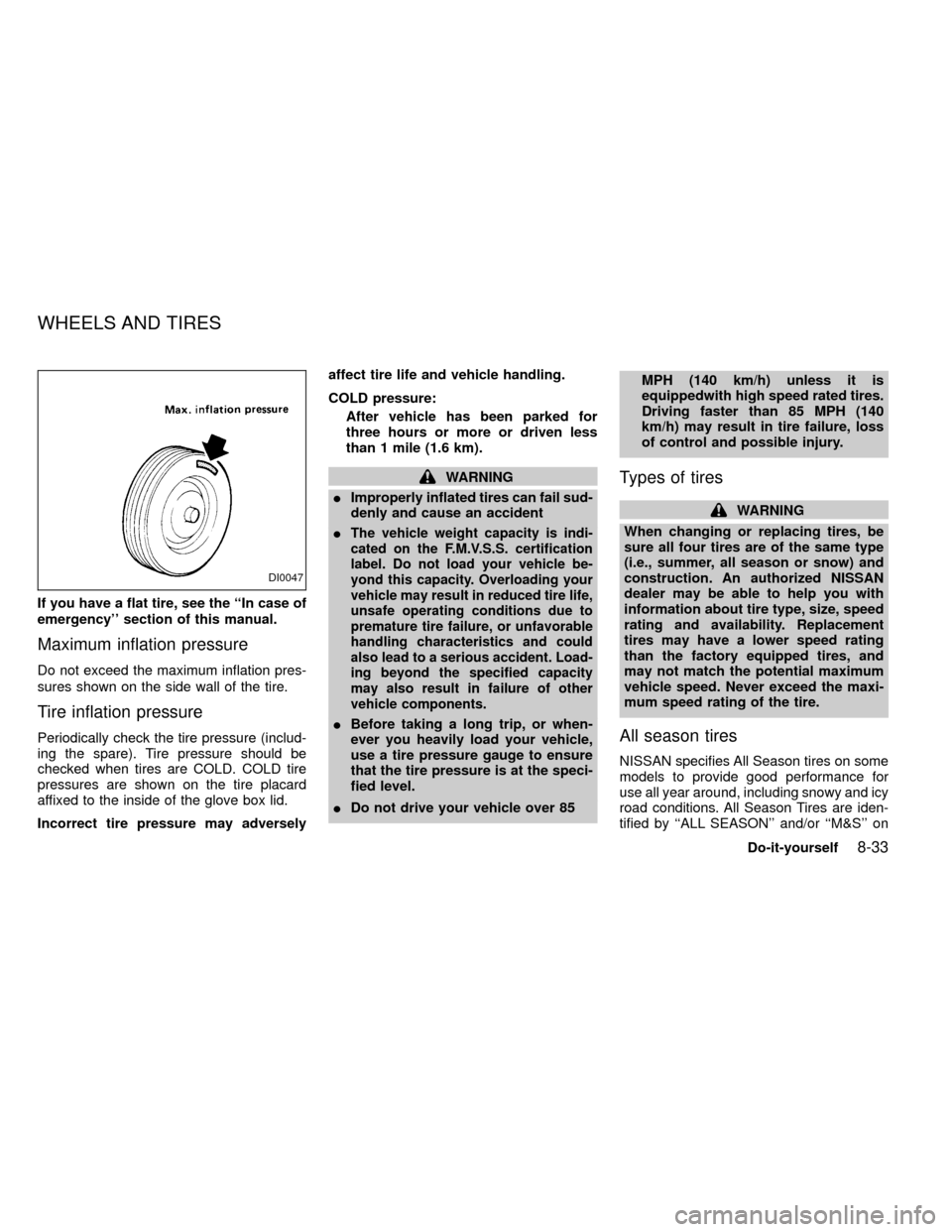
If you have a flat tire, see the ``In case of
emergency'' section of this manual.
Maximum inflation pressure
Do not exceed the maximum inflation pres-
sures shown on the side wall of the tire.
Tire inflation pressure
Periodically check the tire pressure (includ-
ing the spare). Tire pressure should be
checked when tires are COLD. COLD tire
pressures are shown on the tire placard
affixed to the inside of the glove box lid.
Incorrect tire pressure may adverselyaffect tire life and vehicle handling.
COLD pressure:
After vehicle has been parked for
three hours or more or driven less
than 1 mile (1.6 km).
WARNING
IImproperly inflated tires can fail sud-
denly and cause an accident
I
The vehicle weight capacity is indi-
cated on the F.M.V.S.S. certification
label. Do not load your vehicle be-
yond this capacity. Overloading your
vehicle may result in reduced tire life,
unsafe operating conditions due to
premature tire failure, or unfavorable
handling characteristics and could
also lead to a serious accident. Load-
ing beyond the specified capacity
may also result in failure of other
vehicle components.
IBefore taking a long trip, or when-
ever you heavily load your vehicle,
use a tire pressure gauge to ensure
that the tire pressure is at the speci-
fied level.
IDo not drive your vehicle over 85MPH (140 km/h) unless it is
equippedwith high speed rated tires.
Driving faster than 85 MPH (140
km/h) may result in tire failure, loss
of control and possible injury.
Types of tires
WARNING
When changing or replacing tires, be
sure all four tires are of the same type
(i.e., summer, all season or snow) and
construction. An authorized NISSAN
dealer may be able to help you with
information about tire type, size, speed
rating and availability. Replacement
tires may have a lower speed rating
than the factory equipped tires, and
may not match the potential maximum
vehicle speed. Never exceed the maxi-
mum speed rating of the tire.
All season tires
NISSAN specifies All Season tires on some
models to provide good performance for
use all year around, including snowy and icy
road conditions. All Season Tires are iden-
tified by ``ALL SEASON'' and/or ``M&S'' on
DI0047
WHEELS AND TIRES
Do-it-yourself8-33
ZX
Page 217 of 269
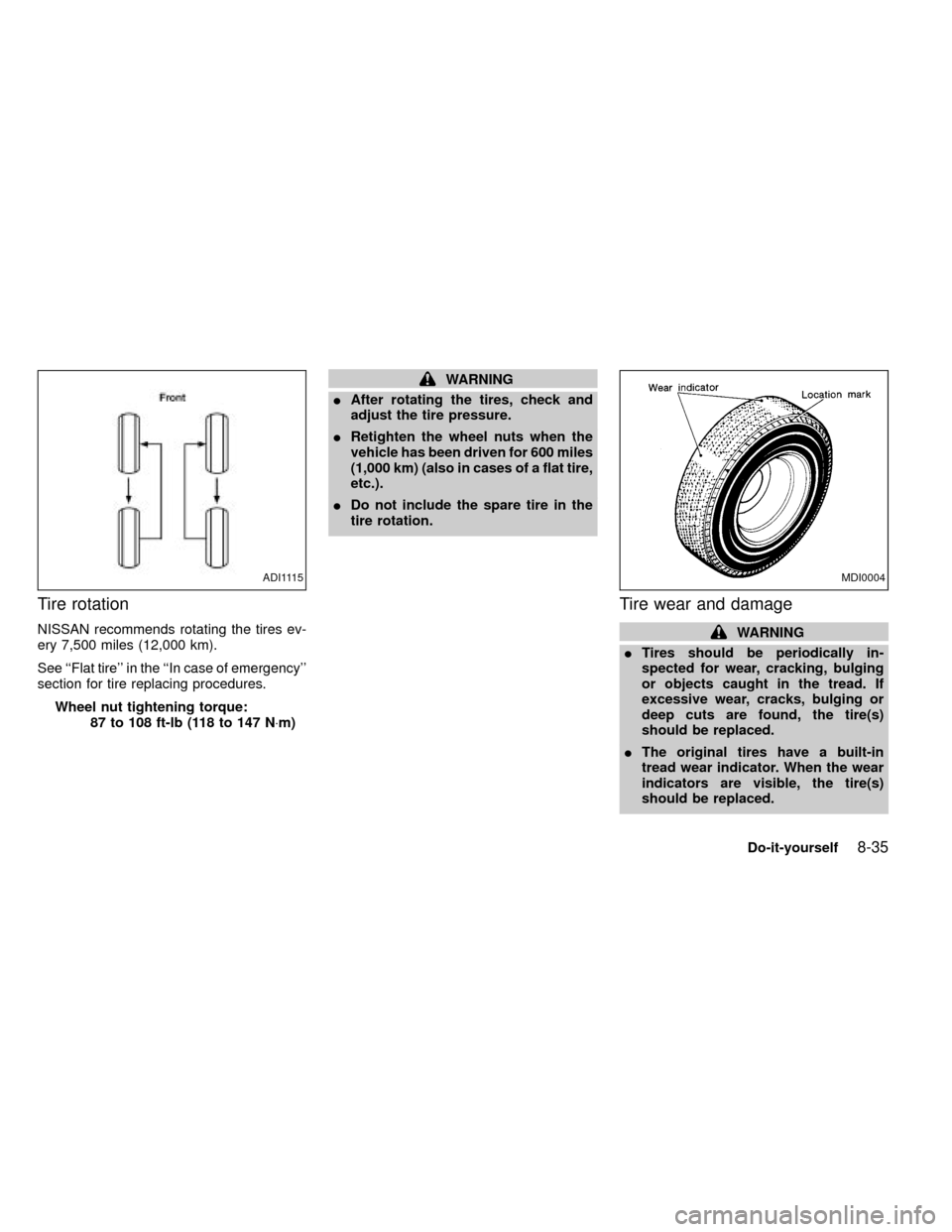
Tire rotation
NISSAN recommends rotating the tires ev-
ery 7,500 miles (12,000 km).
See ``Flat tire'' in the ``In case of emergency''
section for tire replacing procedures.
Wheel nut tightening torque:
87 to 108 ft-lb (118 to 147 N×m)
WARNING
IAfter rotating the tires, check and
adjust the tire pressure.
IRetighten the wheel nuts when the
vehicle has been driven for 600 miles
(1,000 km) (also in cases of a flat tire,
etc.).
IDo not include the spare tire in the
tire rotation.
Tire wear and damage
WARNING
ITires should be periodically in-
spected for wear, cracking, bulging
or objects caught in the tread. If
excessive wear, cracks, bulging or
deep cuts are found, the tire(s)
should be replaced.
IThe original tires have a built-in
tread wear indicator. When the wear
indicators are visible, the tire(s)
should be replaced.
ADI1115MDI0004
Do-it-yourself8-35
ZX
Page 256 of 269
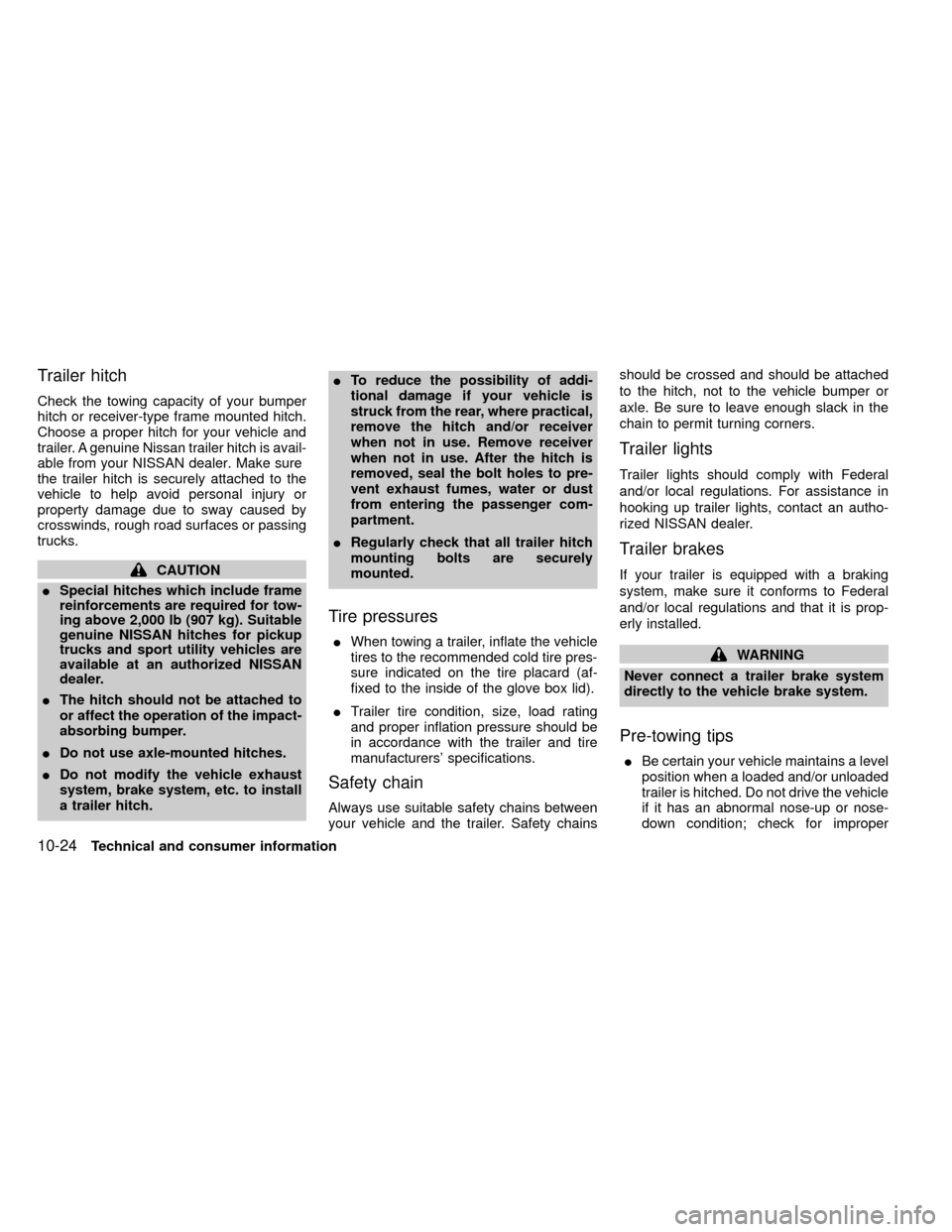
Trailer hitch
Check the towing capacity of your bumper
hitch or receiver-type frame mounted hitch.
Choose a proper hitch for your vehicle and
trailer. A genuine Nissan trailer hitch is avail-
able from your NISSAN dealer. Make sure
the trailer hitch is securely attached to the
vehicle to help avoid personal injury or
property damage due to sway caused by
crosswinds, rough road surfaces or passing
trucks.
CAUTION
ISpecial hitches which include frame
reinforcements are required for tow-
ing above 2,000 lb (907 kg). Suitable
genuine NISSAN hitches for pickup
trucks and sport utility vehicles are
available at an authorized NISSAN
dealer.
IThe hitch should not be attached to
or affect the operation of the impact-
absorbing bumper.
IDo not use axle-mounted hitches.
IDo not modify the vehicle exhaust
system, brake system, etc. to install
a trailer hitch.ITo reduce the possibility of addi-
tional damage if your vehicle is
struck from the rear, where practical,
remove the hitch and/or receiver
when not in use. Remove receiver
when not in use. After the hitch is
removed, seal the bolt holes to pre-
vent exhaust fumes, water or dust
from entering the passenger com-
partment.
IRegularly check that all trailer hitch
mounting bolts are securely
mounted.
Tire pressures
IWhen towing a trailer, inflate the vehicle
tires to the recommended cold tire pres-
sure indicated on the tire placard (af-
fixed to the inside of the glove box lid).
ITrailer tire condition, size, load rating
and proper inflation pressure should be
in accordance with the trailer and tire
manufacturers' specifications.
Safety chain
Always use suitable safety chains between
your vehicle and the trailer. Safety chainsshould be crossed and should be attached
to the hitch, not to the vehicle bumper or
axle. Be sure to leave enough slack in the
chain to permit turning corners.
Trailer lights
Trailer lights should comply with Federal
and/or local regulations. For assistance in
hooking up trailer lights, contact an autho-
rized NISSAN dealer.
Trailer brakes
If your trailer is equipped with a braking
system, make sure it conforms to Federal
and/or local regulations and that it is prop-
erly installed.
WARNING
Never connect a trailer brake system
directly to the vehicle brake system.
Pre-towing tips
IBe certain your vehicle maintains a level
position when a loaded and/or unloaded
trailer is hitched. Do not drive the vehicle
if it has an abnormal nose-up or nose-
down condition; check for improper
10-24Technical and consumer information
ZX
Page 259 of 269
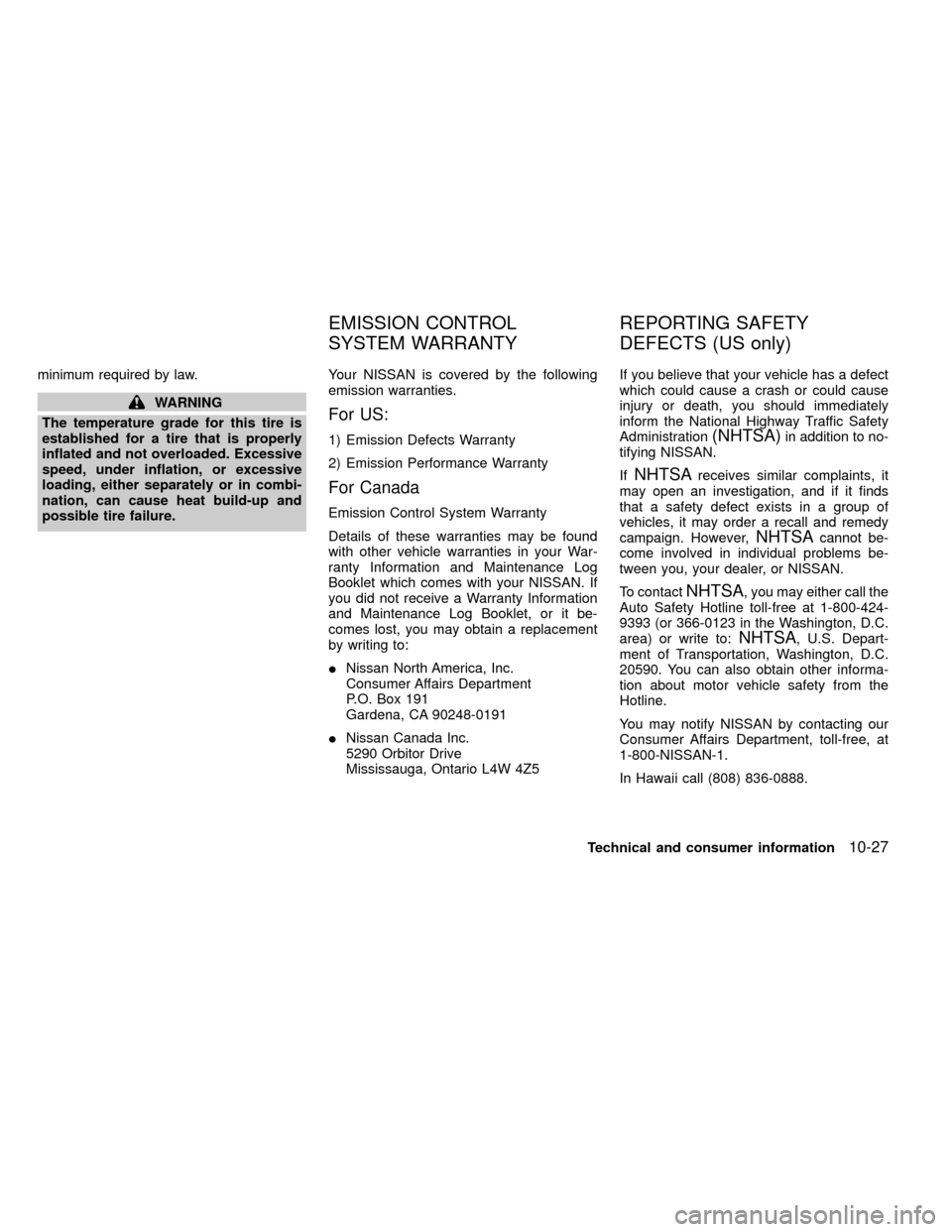
minimum required by law.
WARNING
The temperature grade for this tire is
established for a tire that is properly
inflated and not overloaded. Excessive
speed, under inflation, or excessive
loading, either separately or in combi-
nation, can cause heat build-up and
possible tire failure.Your NISSAN is covered by the following
emission warranties.For US:
1) Emission Defects Warranty
2) Emission Performance Warranty
For Canada
Emission Control System Warranty
Details of these warranties may be found
with other vehicle warranties in your War-
ranty Information and Maintenance Log
Booklet which comes with your NISSAN. If
you did not receive a Warranty Information
and Maintenance Log Booklet, or it be-
comes lost, you may obtain a replacement
by writing to:
INissan North America, Inc.
Consumer Affairs Department
P.O. Box 191
Gardena, CA 90248-0191
INissan Canada Inc.
5290 Orbitor Drive
Mississauga, Ontario L4W 4Z5If you believe that your vehicle has a defect
which could cause a crash or could cause
injury or death, you should immediately
inform the National Highway Traffic Safety
Administration
(NHTSA)in addition to no-
tifying NISSAN.
If
NHTSAreceives similar complaints, it
may open an investigation, and if it finds
that a safety defect exists in a group of
vehicles, it may order a recall and remedy
campaign. However,
NHTSAcannot be-
come involved in individual problems be-
tween you, your dealer, or NISSAN.
To contact
NHTSA, you may either call the
Auto Safety Hotline toll-free at 1-800-424-
9393 (or 366-0123 in the Washington, D.C.
area) or write to:
NHTSA, U.S. Depart-
ment of Transportation, Washington, D.C.
20590. You can also obtain other informa-
tion about motor vehicle safety from the
Hotline.
You may notify NISSAN by contacting our
Consumer Affairs Department, toll-free, at
1-800-NISSAN-1.
In Hawaii call (808) 836-0888.
EMISSION CONTROL
SYSTEM WARRANTYREPORTING SAFETY
DEFECTS (US only)
Technical and consumer information10-27
ZX
Page 264 of 269

Checking engine coolant level ............... 8-5
Engine coolant temperature gauge ........ 2-5
Corrosion protection .................................... 7-4
Cruise control............................................. 5-18
Cup holder ................................................. 2-21
D
Daytime running light system (Canada
only) ........................................................... 2-16
Dimensions and weights .......................... 10-11
Door locks .................................................... 3-2
Drive belts .................................................. 8-18
Driving
Auto-lock free-running hubs ................. 5-22
Cold weather driving............................. 5-30
Driving with automatic transmission ..... 5-14
Driving with manual transmission ......... 5-12
Manual-lock free-running hubs ............. 5-24
Precautions when starting and driving ... 5-2
E
Economy - fuel........................................... 5-20
Emission control information label........... 10-14
Emission control system warranty ........... 10-27
Engine
Before starting the engine ...................... 5-8
Capacities and recommended fuel/
lubricants .............................................. 10-2
Changing engine coolant........................ 8-6Changing engine oil.............................. 8-10
Changing engine oil filter...................... 8-12
Checking engine coolant level ............... 8-5
Checking engine oil level ....................... 8-9
Engine compartment check locations .... 8-3
Engine coolant temperature gauge ........ 2-5
Engine cooling system ........................... 8-5
Engine oil ................................................ 8-9
Engine oil and oil filter
recommendation ................................... 10-6
Engine oil pressure warning light ......... 2-10
Engine oil viscosity ............................... 10-7
Engine serial number ......................... 10-13
Engine specifications ............................ 10-9
Starting the engine ............................... 5-16
Exhaust gas (Carbon monoxide) ................. 5-2
F
Flashers (See hazard warning flasher
switch) ........................................................ 2-19
Flat tire ......................................................... 6-2
Floor mat positioning aid ............................. 7-4
Fluid
Automatic transmission fluid (ATF)....... 8-13
Brake fluid ................................... 10-3, 8-15
Capacities and recommended fuel/
lubricants .............................................. 10-2
Clutch fluid ............................................ 8-15
Engine coolant ........................................ 8-5
Engine oil ................................................ 8-9
Power steering fluid .............................. 8-14Window washer fluid ............................ 8-15
F.M.V.S.S. certification label .................... 10-13
Front seats
Bench...................................................... 1-7
Separate ................................................. 1-2
Fuel
Capacities and recommended fuel/
lubricants .............................................. 10-2
Fuel economy ....................................... 5-20
Fuel filler cap ........................................ 3-11
Fuel gauge.............................................. 2-6
Fuel octane rating................................. 10-5
Fuel recommendation ........................... 10-4
Fuses ......................................................... 8-26
G
Gauge
Engine coolant temperature gauge ........ 2-5
Fuel gauge.............................................. 2-6
Odometer ................................................ 2-3
Speedometer .......................................... 2-3
Tachometer ............................................. 2-5
General maintenance .................................. 9-2
H
Hazard warning flasher switch .................. 2-19
Headlight and turn signal switch ............... 2-16
Headlights .................................................. 8-29
Heater
11-2
ZX
Page 267 of 269

Supplemental restraint system (Supplemental
air bag system) .......................................... 1-10
Switch
Automatic power window switch .......... 2-25
Hazard warning flasher switch ............. 2-19
Headlight and turn signal switch .......... 2-16
Ignition switch ......................................... 5-4
Overdrive switch ................................... 5-13
Passenger supplemental air bag ON/OFF
switch and light ..................................... 1-15
Windshield wiper and washer switch ... 2-17
T
Tachometer .................................................. 2-5
Tailgate latch .............................................. 3-13
Theft warning ............................................. 2-14
Three way catalyst....................................... 5-2
Tie down hooks.......................................... 3-14
Tilting steering wheel ................................. 3-15
Tire
Flat tire.................................................... 6-2
Spare tire .............................................. 8-37
Tire chains ............................................ 8-34
Tire placard ......................................... 10-14
Tire pressure......................................... 8-33
Tire rotation........................................... 8-35
Tires of 4-wheel drive ........................... 8-36
Types of tires ........................................ 8-33
Uniform tire quality grading ................ 10-27
Wheels and tires................................... 8-33
Wheel/tire size .................................... 10-10Towing
2-wheel drive models ........................... 6-12
4-wheel drive models ........................... 6-12
Tow truck towing ................................... 6-11
Towing load/specification chart ........... 10-23
Trailer towing ...................................... 10-21
Transfer case ............................................. 5-21
Transmission
Automatic transmission fluid (ATF)....... 8-13
Driving with automatic transmission ....... 5-8
Driving with manual transmission ......... 5-14
Selector lever lock release ................... 5-12
Travel (See registering your vehicle in another
country) .................................................... 10-12
Trip odometer .............................................. 2-4
Truck - camper loading ............................ 10-17
Turn signal switch (See headlight and turn
signal switch) ............................................. 2-16
U
Uniform tire quality grading ..................... 10-26
V
Vanity mirror............................................... 3-17
Vehicle dimensions and weights.............. 10-11
Vehicle identification number (VIN) (chassis
number).................................................... 10-12
Vehicle identification number (VIN)
plate ......................................................... 10-12
Vehicle loading information...................... 10-15Vehicle recovery ........................................ 6-13
Ventilators .................................................... 4-2
W
Warning
Air bag warning light............................. 1-18
Hazard warning flasher switch ............. 2-19
Theft warning ........................................ 2-14
Warning labels (for SRS)...................... 1-18
Warning/indicator lights and chimes....... 2-8
Weights (See dimensions and weights) .. 10-11
Wheels and tires ........................................ 8-31
Wheel/tire size ......................................... 10-10
When traveling or registering your vehicle in
another country ........................................ 10-12
Window washer fluid.................................. 8-15
Windows
Manual windows ................................... 2-23
Power windows..................................... 2-24
Rear sliding window ............................. 2-25
Windshield wiper and washer switch ........ 2-17
Wiper
Windshield wiper and washer switch ... 2-17
Wiper blades......................................... 8-22
11-5
ZX
Page 268 of 269
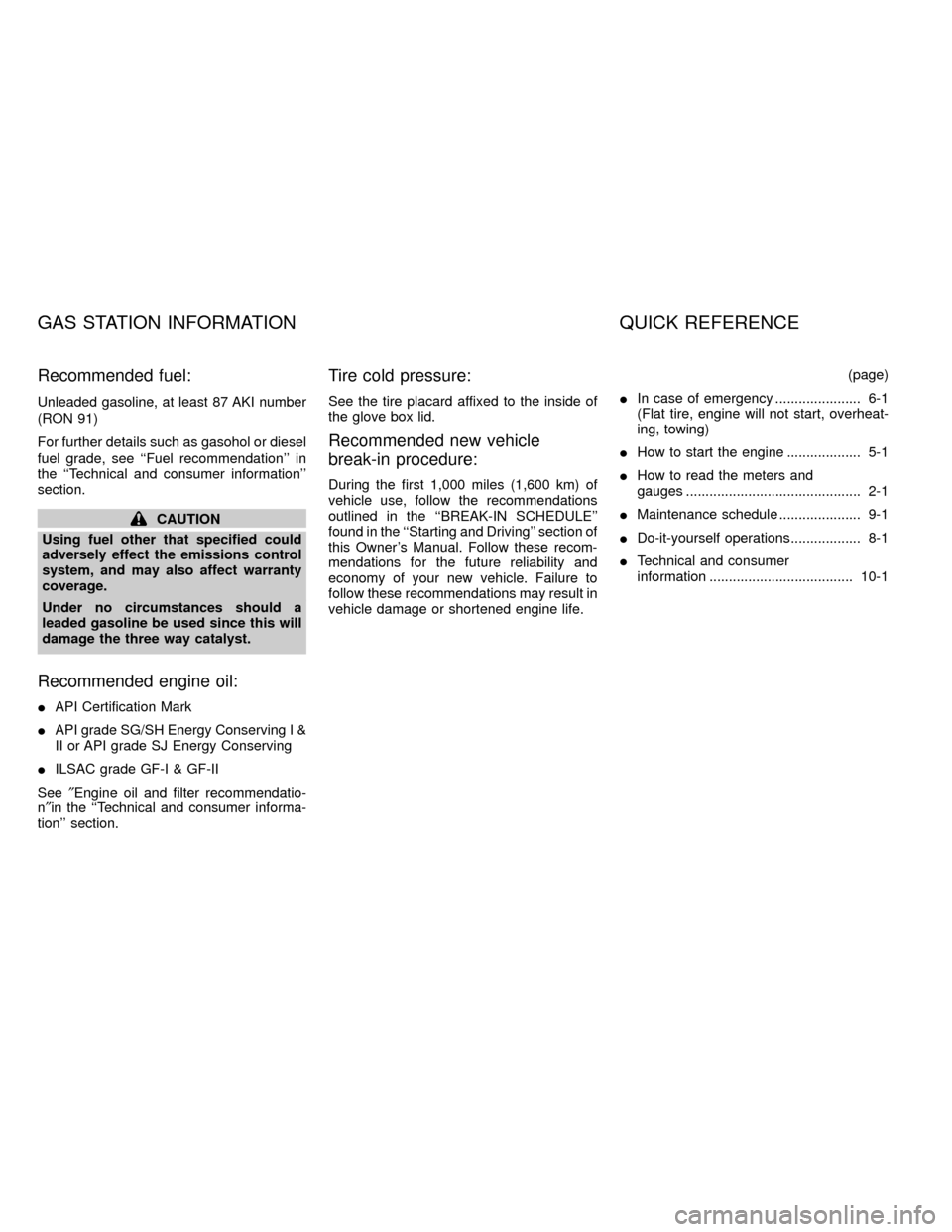
Recommended fuel:
Unleaded gasoline, at least 87 AKI number
(RON 91)
For further details such as gasohol or diesel
fuel grade, see ``Fuel recommendation'' in
the ``Technical and consumer information''
section.
CAUTION
Using fuel other that specified could
adversely effect the emissions control
system, and may also affect warranty
coverage.
Under no circumstances should a
leaded gasoline be used since this will
damage the three way catalyst.
Recommended engine oil:
IAPI Certification Mark
IAPI grade SG/SH Energy Conserving I &
II or API grade SJ Energy Conserving
IILSAC grade GF-I & GF-II
See²Engine oil and filter recommendatio-
n²in the ``Technical and consumer informa-
tion'' section.
Tire cold pressure:
See the tire placard affixed to the inside of
the glove box lid.
Recommended new vehicle
break-in procedure:
During the first 1,000 miles (1,600 km) of
vehicle use, follow the recommendations
outlined in the ``BREAK-IN SCHEDULE''
found in the ``Starting and Driving'' section of
this Owner's Manual. Follow these recom-
mendations for the future reliability and
economy of your new vehicle. Failure to
follow these recommendations may result in
vehicle damage or shortened engine life.(page)
IIn case of emergency ...................... 6-1
(Flat tire, engine will not start, overheat-
ing, towing)
IHow to start the engine ................... 5-1
IHow to read the meters and
gauges ............................................. 2-1
IMaintenance schedule ..................... 9-1
IDo-it-yourself operations.................. 8-1
ITechnical and consumer
information ..................................... 10-1
GAS STATION INFORMATION QUICK REFERENCE
ZX